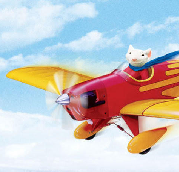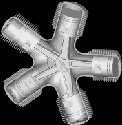|
PT6A posted:Question for instructors: based on a conversation on teaching stalls I was having with my co-workers last night, how do you go about teaching stall recovery? To put the aircraft in a stall, I typically complete safety checks, establish the desired power setting and maintain altitude until the first indications of an impending stall in the slow-flight range. At this point, and this is where I diverged from my fellow instructors, I "assertively" move the controls full aft until the stall occurs, with less focus on maintaining altitude during the entry and more focus on showing the distinction between the approach-to-stall and the stall itself. Not 100% sure how it is in America’s hat with regards to testing standards, but technique wise you’re in the right here. Maintaining altitude during a stall is a relatively old airline way of thinking that went out the window with the Colgan crash.
|
|
|
|

|
| # ? May 17, 2024 12:09 |
|
e.pilot posted:Not 100% sure how it is in America’s hat, but you’re in the right here. Maintaining altitude during a stall is a relatively old airline way of thinking that went out the window with the Colgan crash. Yeah, they aren't even talking about minimizing altitude loss during the recovery, but the entry. I find, especially in a 172, without significant control input to induce the stall it can be difficult, especially at low power settings, for the student to identify the stall at first, which is why I identify the symptoms of approach-to-stall and then move the controls all the way aft to actually stall the aircraft, rather than attempting to maintain a level altitude all the way into the stall. That's the point of disagreement. I maintain that the point of the exercise -- with reference to the flight test guide -- is to identify the approach to stall, stall the plane, identify the stall, then recover, and that any focus inside the cockpit after the approach to stall (for example, to maintain a consistent altitude) is counterproductive.
|
|
|
|
I think the question here is less about post-stall and more about the approach to the stall in the exercise itself, rather than what is best practice for recovering from a stall. I always went with the idea that while it is important to show and demonstrate stalls and recovery in their most basic form, it's even more important to teach students to recognise and recover from stalls with the aircraft in a plausible, real-world type of scenario. I would question the benefit of showing a student what is effectively a low-speed accelerated stall by going full aft on the control column, because while it does get the aircraft to stall far more readily, what is the real-world benefit in doing that? Transport Canada has an excellent document on this, it was my guide for any exercises: https://www.tc.gc.ca/media/documents/ca-publications/tp13747e.pdf Also in something completely unrelated, I know it's kind of hilarious to see great big TAFs, but this has to be the shortest one I've ever seen: TAF CYYC 032038Z 0321/0418 VRB03KT P6SM SKC RMK NXT FCST BY 040000Z=
|
|
|
|
Here's my two cents: Power off stalls are a demonstration of how to identify and recover from a stall on approach or landing. Power on stalls are a demonstration of how to identify and recover from a stall on departure. As long as your entry isn't unsafe in some way I can't imagine an examiner having a problem with it. Back when I was an instructor I tought my students to treat power off talls like a simulated traffic pattern including establishing themselves on a "stable approach" including a descent. I never had any sort of negative feedback from examiners when my students did this. It's worth noting that a lot of instructors tell their students that setting up stalls is "just like slow flight except with an intentional stall" which may be where the confusion about +/-100' is coming from.
|
|
|
|
|
MrChips posted:I think the question here is less about post-stall and more about the approach to the stall in the exercise itself, rather than what is best practice for recovering from a stall. I always went with the idea that while it is important to show and demonstrate stalls and recovery in their most basic form, it's even more important to teach students to recognise and recover from stalls with the aircraft in a plausible, real-world type of scenario. I would question the benefit of showing a student what is effectively a low-speed accelerated stall by going full aft on the control column, because while it does get the aircraft to stall far more readily, what is the real-world benefit in doing that? Thanks, this makes a lot of sense. I think the real issue is that I’ve been doing it wrong, but also my coworkers have been doing it wrong. If a power-off stall simulates an arrival stall then it should be entered from a descent initially, and if a power-on stall simulates a departure stall then it should be entered from a climb. So then the question becomes: what’s the best way to get students familiar with stall recovery initially before introducing these situations, and to that end I think my method works because the stall tends to be very clear, and basic recovery can be practiced until sufficient to handle actual situations. On the other hand, entering a stall directly from slow flight builds more naturally on what’s been taught immediately before, so I see value in that too. I also wish my co-workers took less of an “I AM RIGHT YOU ARE WRONG” attitude because clearly we all missed, during these discussions, the points you brought up. We should try to be less defensive about our own techniques because if we can’t discuss different ideas and ways to improve, then we’re stuck with the results of a decades-long game of telephone. I really appreciate feedback from other instructors and students here because y’all are cool and not judgemental/aggressively drunk 
|
|
|
|
Power off in the US requires a descent to simulate an approach, to do it to ACS standards. Power on we'll normally slow down to Vr+5 or so and then apply full power, but I don't think that's an ACS requirement. The way I normally teach power off specifically is to put the nose on the horizon to "stretch the glide" and hold it there, noting it takes more control pressure all the way to the stall break just to keep it level. The reason why is because I feel like it better simulates the actual scenario when you'd stall on approach- Not yanking to ten degrees nose high with power idle, but on the horizon and ignoring your airspeed as it winds down. I also sprinkle in "Okay, you're in slow flight, let's see a power off stall from here" to save a bit of time and connect the low airspeed regime to how you'd actually stall it. The only problem with this is that some of our aircraft have stall characteristics in which you do this and the stall break never happens, you just peg the VSI to -1000 or so and that's when you know you've stalled. To get a full stall break you do have to pull to 10 degrees nose up. Also of note is that the altitude loss requirement in the ACS is "Minimum", not a number, which I believe was a change after the Colgan crash.
|
|
|
|
Some of our instructor candidates have asked me “when do you stop feeling like you don’t know anything?” and I’m always like, “if I find out, I’ll let you know.”
|
|
|
|
When your name is Jerry Wagner.
|
|
|
|
I've always said that the day I feel like I know everything there is to know about flying is the day I walk away from it.
|
|
|
|
e.pilot posted:Not 100% sure how it is in America’s hat with regards to testing standards, but technique wise you’re in the right here. Maintaining altitude during a stall is a relatively old airline way of thinking that went out the window with the Colgan crash. As mentioned above he was talking about stall entry. I agree with what has been said already, entry should just happen, not be forced. As for recovery, a lot has changed since many of us went thru training. My training has completely changed, focus on getting the nose down, gaining airspeed, and then recovering, altitude be damned. AWSEFT fucked around with this message at 02:47 on Mar 20, 2019 |
|
|
|
a patagonian cavy posted:Power off in the US requires a descent to simulate an approach, to do it to ACS standards. Power on we'll normally slow down to Vr+5 or so and then apply full power, but I don't think that's an ACS requirement. The way I normally teach power off specifically is to put the nose on the horizon to "stretch the glide" and hold it there, noting it takes more control pressure all the way to the stall break just to keep it level. The reason why is because I feel like it better simulates the actual scenario when you'd stall on approach- Not yanking to ten degrees nose high with power idle, but on the horizon and ignoring your airspeed as it winds down. I also sprinkle in "Okay, you're in slow flight, let's see a power off stall from here" to save a bit of time and connect the low airspeed regime to how you'd actually stall it. I'm not an instructor, but I like this guy's approach. Level flight with a power setting that can't keep you there taught me more about power off stalls than any other method.
|
|
|
|
Sometimes you can't get it to stall without a little bit of forcing (be it with a little power, and/or a quick pull from a few knots faster). Some planes don't have the up-elevator authority at forward CG's. And just letting the nose come down due to a lack of lift due to a lack of speed, furthers the misperception that "the nose went down" is a stall.
|
|
|
|
Just hold the elevator to the stops, dance on the rudder, and do a leaf stall. 
|
|
|
|
e.pilot posted:Just hold the elevator to the stops,
|
|
|
|
Got an e-mail today from my flight school looking for me to pay off my balance. Funny, when the e-mail came in I was in the middle of posting all my books and knee board and stuff as well as all my flight sim hardware for sale on Kijiji. End of an era.
|
|
|
|
Abort after V1 because the elevator was stuck, apparently in a way that wouldn't have been caught in pre-flight. https://deadspin.com/ntsb-report-michigans-2017-plane-accident-was-a-couple-1833144676 NTSB Report posted:The flight crew positioned the airplane for departure from runway 23L, and, at 1451:12, the check airman called for the captain to begin the takeoff roll. At 1451:55, the check airman called “V1.” Six seconds later (at 1452:01), he called “rotate,” followed 3 seconds later (at 1452:04)by “V2.” At 1452:05, the captain said, “hey, what’s goin’ on?” and, 3 seconds later, “abort.” The check airman stated, “no, not above…” and then “…don’t abort above V1 like that,” and the captain replied, “it wasn’t flying.” NTSB Report posted:Had the check airman simply reacted and assumed control of the airplane after the captain decided to reject, the results could have been catastrophic if such action were to further delay the deceleration (at best) or to try to continue the takeoff in an airplane that was incapable of flight. Thus, the NTSB concludes that the check airman’s disciplined adherence to company [standard operating procedures] after the captain called for the rejected takeoff likely prevented further damage to the airplane and reduced the possibility of serious or fatal injuries to the crew and passengers. So how does the flight control check work when you can't walk back and give everything a little wiggle?
|
|
|
|
There are control position indicators on the MFDs that move with control input. Or you make the FO stand outside and watch during the preflight. God I hate the voice that article is written in. It's like nails on a chalkboard. In my eyeballs. The Ferret King fucked around with this message at 16:18 on Mar 8, 2019 |
|
|
|
Newer airplanes will show you where the control surfaces are on the mfd’s but thousands of airplanes in service today do not (including every 737 ever built) and I guarantee nobody is getting out and checking during the control check.
|
|
|
|
dupersaurus posted:So how does the flight control check work when you can't walk back and give everything a little wiggle? You just hope it works. The DC-9 controls the displacement of the elevator via servo tabs. There is no direct control of the elevator, just the tabs that move to "encourage" the elevator to work. That's why if you see any of the remaining DC-9 variants taxiing, the elevators can be positioned all cockeyed and moving around in medium winds. I believe that was the problem with the accident aircraft, it had been parked in high, gusty winds and the elevator sections were damaged to the point that they were jammed. Reason #57 why I'm not a fan of old McDonnell Douglas aircraft. They did some weird poo poo that probably wasn't the most elegant way to engineer stuff. They did use super-thick fuselage skin, though. If you fly on a Delta MD-88/90 some time, check out the thickness of the skin as you're going through the boarding door. It's WAY thicker than the skin Boeing used on all of their aircraft.
|
|
|
|
ausgezeichnet posted:That's why if you see any of the remaining DC-9 variants taxiing, the elevators can be positioned all cockeyed and moving around in medium winds. Hence... 
|
|
|
|
I know what you meant, butThe Ferret King posted:There are control position indicators on the MFDs that move with control Otherwise it would be pointless; you already know the yoke is moving if you're moving it. vessbot fucked around with this message at 00:53 on Mar 9, 2019 |
|
|
|
A fun question to ask students during the controls check: without looking at them, which aileron should be up and which should be down? Lots of people forget the "correct" part of "free and correct."
|
|
|
|
Thumbs up
|
|
|
|
PT6A posted:A fun question to ask students during the controls check: without looking at them, which aileron should be up and which should be down? Terrifying corollary: ask mechanics which aileron should be up after a control cable re-rig. Did we just end up with redundant flaps? Extraneous spoilers? It's even more scary when your yoke doesn't act on the control surface directly. Now you move the yoke and as "which servo tab is up?" or "which spoileron is up?" or "which rudder bias cable should be tight?"
|
|
|
|
I'm confused, is there some reason to not have gustlocks on planes (re: that accident above)?
|
|
|
|
Per posted:I'm confused, is there some reason to not have gustlocks on planes (re: that accident above)? You climb up the t-tail and install it. All aircraft have design decisions. This aircraft wasn't knowingly exposed to conditions outside its limitations. Localized conditions probably caused a situation outside its limitations which was undetectable to flight crew before the takeoff roll. Modern aircraft are unlikely to be designed this way.
|
|
|
|
babyeatingpsychopath posted:Terrifying corollary: ask mechanics which aileron should be up after a control cable re-rig. I would rather not consider the things mechanics don't know as based on what I've seen I'm already worried the list is much longer than I'd like.
|
|
|
|
So the V-22 has a preflight e-BIT for its FCS system...initiate it and it moves around all the control surfaces, tests all the hydraulic systems, etc. We do a control check to ensure surfaces are deflecting properly etc. Do fixed wing airplanes using fly by wire do this? Like, would the flight control computers be aware that they couldn't move a surface?
|
|
|
|
Most (all?) flight control systems measure the physical position of the flight controls.
|
|
|
|
Bob A Feet posted:So the V-22 has a preflight e-BIT for its FCS system...initiate it and it moves around all the control surfaces, tests all the hydraulic systems, etc. We do a control check to ensure surfaces are deflecting properly etc. Do fixed wing airplanes using fly by wire do this? Like, would the flight control computers be aware that they couldn't move a surface? Depends on the aircraft, but typically yes to some extent.
|
|
|
|
Bob A Feet posted:So the V-22 has a preflight e-BIT for its FCS system...initiate it and it moves around all the control surfaces, tests all the hydraulic systems, etc. We do a control check to ensure surfaces are deflecting properly etc. Do fixed wing airplanes using fly by wire do this? Like, would the flight control computers be aware that they couldn't move a surface? The 7X does. SOP has us doing a manual flight control check while observing a synoptic diagram of the Flight Control System. Next is a BIT test of the FCS system which wiggles all the control surfaces, Trimmable Horizontal Stabilizer and slats/flaps. The system is sensitive enough that if the aircraft is positioned in a certain way with big or gusty winds, we can get fault messages during either of the FCS checks. Mostly elevator actuator faults with big tailwinds during the manual check and aileron faults during the FCS test. Having experienced this a lot in nine years in the aircraft, I'll reposition the aircraft into the wind before running the checks to avoid the potential faults.
|
|
|
|
Another 738 Max crashed, this time in Ethiopia: https://www.wesh.com/article/ethiop...vP_NHsyjly4Uvecausgezeichnet posted:You just hope it works. The DC-9 controls the displacement of the elevator via servo tabs. There is no direct control of the elevator, just the tabs that move to "encourage" the elevator to work. That's why if you see any of the remaining DC-9 variants taxiing, the elevators can be positioned all cockeyed and moving around in medium winds. I believe that was the problem with the accident aircraft, it had been parked in high, gusty winds and the elevator sections were damaged to the point that they were jammed. Reason #57 why I'm not a fan of old McDonnell Douglas aircraft. They did some weird poo poo that probably wasn't the most elegant way to engineer stuff. I'm going on an MD-88 and a 739 later today and am going to do this.
|
|
|
|
Some data about the two 737 max 8 crashes https://thepointsguy.com/news/similarities-lion-air-ethiopian-737-max-crashes/ 2 out of 350 have crashed 5,000 are on order
|
|
|
|
|
Is there a goon thread for these crashes? Also would you guys now have reservations flying a 737 max 8?
|
|
|
|
MOVIE MAJICK posted:Is there a goon thread for these crashes? Also would you guys now have reservations flying a 737 max 8? I wouldn't, but I'm a Harrier pilot so my risk-aversion sense is obviously broken. More seriously, I dunno. It's a personal decision. They're probably not fundamentally broken? We just don't know yet. There's a lot of other ways in which aviation safety happens which is why even if there is Something Wrong With Them you aren't seeing them all crash all the time. Just like every other day in commercial aviation, you're probably fine. Are you slightly/infinitesimally less fine on a MAX 8? Well, seems that way, for now.
|
|
|
|
If a MAX crashes here or in another western country then get worried, otherwise it’s just third world aviation.
|
|
|
|
From the OSHA thread:Icon Of Sin posted:If you’re going to be out on a runway, it’s probably best to make sure it’s closed first.
|
|
|
|
Oh man, the OSHA thread keeps on giving today: Synthbuttrange posted:https://www.youtube.com/watch?v=S-VoWrp7Kxg&t=31s
|
|
|
|
Arson Daily posted:If a MAX crashes here or in another western country then get worried, otherwise it’s just third world aviation. gently caress off, Ethiopian Airlines is as legit as it gets.
|
|
|
|

|
| # ? May 17, 2024 12:09 |
|
Ethiopian Airlines is the most reputable and well regarded airline in Africa and not too shabby on the world stage either. Two all-lives-lost, apparently nearly-identical incidents in a few months, with an airframe that was brand new, should get your hackles up whether they're "third world" or not.
|
|
|






























